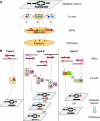Systems biology of SNPs
- PMID: 16820779
- PMCID: PMC1681509
- DOI: 10.1038/msb4100077
Systems biology of SNPs
Abstract
Genome-scale networks can now be reconstructed based on high-throughput data sets. Mathematical analyses of these networks are used to compute their candidate functional or phenotypic states. Analysis of functional states of networks shows that the activity of biochemical reactions can be highly correlated in physiological states, forming so-called co-sets representing functional modules of the network. Thus, detrimental sequence defects in any one of the genes encoding members of a co-set can result in similar phenotypic consequences. Here we show that causal single nucleotide polymorphisms in genes encoding mitochondrial components can be classified and correlated using co-sets.
Figures


Similar articles
-
Identification of functional modules using network topology and high-throughput data.BMC Syst Biol. 2007 Jan 26;1:8. doi: 10.1186/1752-0509-1-8. BMC Syst Biol. 2007. PMID: 17408515 Free PMC article.
-
Genes and pathways contributing to obesity: a systems biology view.Prog Mol Biol Transl Sci. 2010;94:9-38. doi: 10.1016/B978-0-12-375003-7.00002-9. Prog Mol Biol Transl Sci. 2010. PMID: 21036321 Review.
-
Properties of metabolic networks: structure versus function.Biophys J. 2005 Jan;88(1):L07-9. doi: 10.1529/biophysj.104.055723. Epub 2004 Dec 1. Biophys J. 2005. PMID: 15574705 Free PMC article.
-
In silico analysis of SNPs and other high-throughput data.Methods Mol Biol. 2007;366:267-85. doi: 10.1007/978-1-59745-030-0_15. Methods Mol Biol. 2007. PMID: 17568130
-
Dynamic variable selection in SNP genotype autocalling from APEX microarray data.BMC Bioinformatics. 2006 Nov 30;7:521. doi: 10.1186/1471-2105-7-521. BMC Bioinformatics. 2006. PMID: 17137502 Free PMC article.
Cited by
-
Global reconstruction of the human metabolic network based on genomic and bibliomic data.Proc Natl Acad Sci U S A. 2007 Feb 6;104(6):1777-82. doi: 10.1073/pnas.0610772104. Epub 2007 Jan 31. Proc Natl Acad Sci U S A. 2007. PMID: 17267599 Free PMC article.
-
A detailed genome-wide reconstruction of mouse metabolism based on human Recon 1.BMC Syst Biol. 2010 Oct 19;4:140. doi: 10.1186/1752-0509-4-140. BMC Syst Biol. 2010. PMID: 20959003 Free PMC article.
-
Prioritizing candidate disease metabolites based on global functional relationships between metabolites in the context of metabolic pathways.PLoS One. 2014 Aug 25;9(8):e104934. doi: 10.1371/journal.pone.0104934. eCollection 2014. PLoS One. 2014. PMID: 25153931 Free PMC article.
-
Drug transporters OAT1 and OAT3 have specific effects on multiple organs and gut microbiome as revealed by contextualized metabolic network reconstructions.Sci Rep. 2022 Oct 31;12(1):18308. doi: 10.1038/s41598-022-21091-w. Sci Rep. 2022. PMID: 36316339 Free PMC article.
-
A Next Generation Multiscale View of Inborn Errors of Metabolism.Cell Metab. 2016 Jan 12;23(1):13-26. doi: 10.1016/j.cmet.2015.11.012. Epub 2015 Dec 17. Cell Metab. 2016. PMID: 26712461 Free PMC article. Review.
References
-
- Borodina I, Nielsen J (2005) From genomes to in silico cells via metabolic networks. Curr Opin Biotechnol 16: 350–355 - PubMed
-
- Camacho JA, Rioseco-Camacho N, Andrade D, Porter J, Kong J (2003) Cloning and characterization of human ORNT2: a second mitochondrial ornithine transporter that can rescue a defective ORNT1 in patients with the hyperornithinemia–hyperammonemia–homocitrullinuria syndrome, a urea cycle disorder. Mol Genet Metab 79: 257–271 - PubMed
Publication types
MeSH terms
LinkOut - more resources
Full Text Sources
Other Literature Sources

